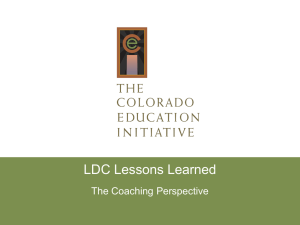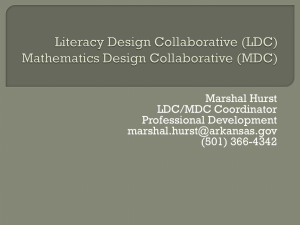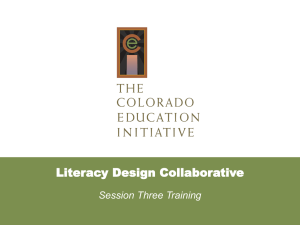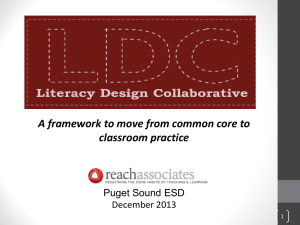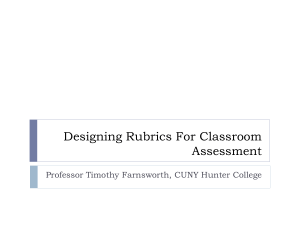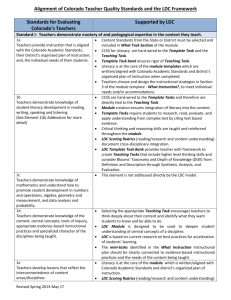LDC Cohort 2 – Dec 12 – Kathy - CORElaborate
advertisement
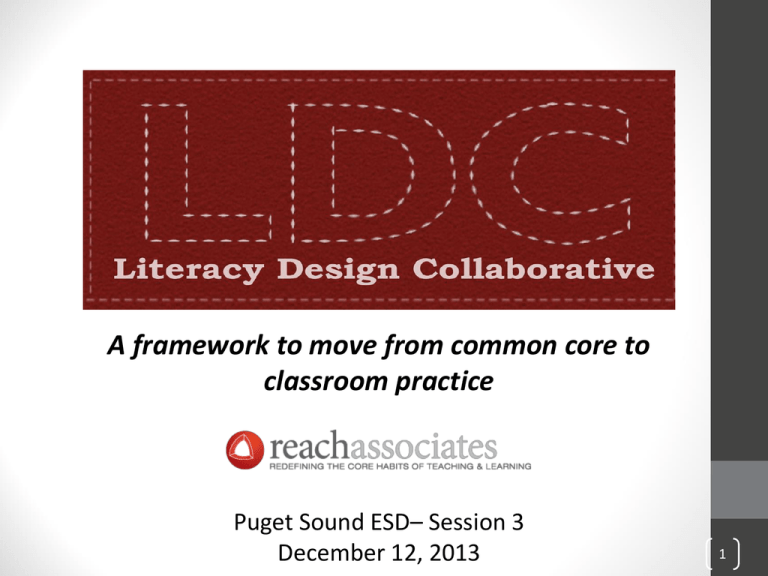
A framework to move from common core to classroom practice Puget Sound ESD– Session 3 December 12, 2013 1 Overview of the Sessions 2 Outcomes • Deepen understanding of each section in the LDC Framework and how each section supports implementing the Common Core Standards • Understand the 7 elements and scoring used on the LDC Informational Rubrics • Calibrate scoring • Score student work samples • Jury a module and use findings to plan future instruction (mini tasks) and/or future modules 3 Norms • What working agreements will help make today be successful for you? 4 Overview of the LDC Framework 5 What Task? The the Core of the LDC Framework “What was different in the four classrooms was what students were actually being asked to do, and the degree to which the teacher was able to engage students in the work by scaffolding their learning up to the complexity of the task she was asking them to do.” – Richard Elmore Rounds in Education. lizabeth A. City, Richard F. Elmore, Sarah E. Fiarman, and Lee Teitel 6 Why the emphasis on tasks? LDC Template Task Teaching Task Teachers fill–in-the-blank by choosing: Template Task 14 (Informational or Explanatory/Description) (_______) After reading _____, write a _______that describes (content) and addresses the question. Support your discussion with evidence from the text(s). Teaching Task: Why was America called the land of opportunity by millions of immigrants who came to the United States from many different countries? After reading selected informational text, primary source documents and viewing multimedia, write an informational essay that describes the immigrants’ journey to America and their initial experiences and addresses the question. Support your discussion with evidence from the text(s). 7 text - writing product - content - text structure Strong Teaching Tasks… • Are worthy of 2, 3 or 4 weeks of instruction; • Provide opportunities to address text complexity and the use of informational text as called for in the CCSS; • Have students working in the most effective mode of discourse/text structure; • Evolve from a rigorous text-dependent question; • Provide an authentic audience. 8 • Ask students to grapple with an issue central to the discipline; What Skills Teaching Task: Why was America called the land of opportunity by millions of immigrants who came to the United States from many different countries? After reading selected informational text, primary source documents and viewing multimedia, write an essay that describes the immigrants’ journey to America and some of their initial experiences and addresses the question. Support your discussion with evidence from the text(s). Template Task 14 Informational/Description) 9 By deconstructing the teaching task the needed skills are identified. Each skill cluster is broken into specific skills which helps guides teacher in planning instruction. Skill Cluster 1: Preparing for the Task Definition Ability to connect the task and new content to existing Task Engagement knowledge, skills, experiences, interests, and concerns. * CCSS – 11-12 R.SS.7: Integrate and evaluate multiple sources of information presented in diverse formats and media in order to address a question or solve a problem. Task Analysis Ability to understand and explain the task’s prompt and rubric. * CCSS – 11-12 R.SS.2: Determine the central ideas or information of a primary or secondary source; provide an accurate summary that makes clear the relationships among the key details and ideas. 10. Skill What Instruction? Each skill is organized into an instructional plan or ladder: skill prompt and product scoring guide instructional strategies 11 pacing The instruction for each skill is called the “mini-task”. What Results? – Section 4 Scoring Student Work with the LDC Rubric • Can be used to score holistically or analytically • 2 rubrics – Informative/explanatory & Argumentative • 7 Scoring Elements: • • • • • • • Focus Controlling Idea Reading/Research Development Organization Conventions Content Understanding 12. The LDC rubric… •provides feedback to students and teachers •helps students know expectations prior to completing the task •helps teachers gauge the effectiveness of their instructional choices 13 LDC Rubrics – Scoring v. Grading 14 Collaborative Scoring Translating the Rubric • With a partner, translate each section of the rubric, considering the following factors: • A translation of the rubric category in your own words. • An example of what it looks like in the final written product. 15 Scoring Student Work • Independent Scoring: • After reading the student essay, identify a score for each rubric category. • Corroborating Scores: • Corroborate table scores for each category & and decide on a holistic score. 17 Student Feedback • For which rubric categories (i.e. skills) does this student need the most support? • What strategies could you employ to support this student in learning those skills? 18 Analyzing Results 19 Jurying Modules 20 Jurying a Module - Section 1: What Task - Section 2: What Skills - Section 3: What Instruction 21 Using a guiding protocol Use findings from juried module and/or student work to plan future instruction (mini tasks) and/or future modules 22 Next Steps
